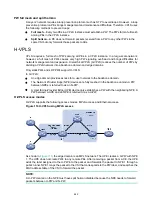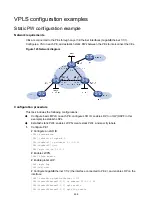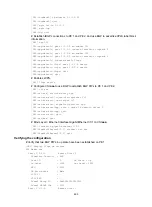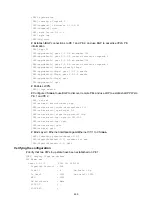
454
Step Command
Remarks
5.
Configure an LDP PW and
enter VSI LDP PW view.
peer
ip-address
[
pw-id
pw-id
]
[
hub
|
no-split-horizon
|
pw-class
class-name
|
tunnel-policy
tunnel-policy-name
]
*
By default, no LDP PWs exist.
6.
Configure a backup LDP PW
and enter VSI LDP backup
PW view.
backup-peer
ip-address
[
pw-id
pw-id
] [
pw-class
class-name
|
tunnel-policy
tunnel-policy-name
]
*
By default, no backup LDP PW
exists.
If both the default PW ID in the
default-pw-id
command and a
PW ID in the
backup-peer
command are configured, the
PW ID in the
backup-peer
command is used. If only the
default PW ID is configured, the
default PW ID is used. If no
default PW ID is configured, you
must provide a PW ID in the
backup-peer
command.
7.
Return to user view.
return
N/A
8.
Manually switch traffic of the
specified PW to its backup
PW.
l2vpn switchover peer
ip-addres
s
pw-id
pw-id
N/A
Configuring MAC address learning
Step Command
Remarks
1.
Enter system view.
system-view
N/A
2.
Enter VSI view.
vsi
vsi-name
[
hub-spoke
] N/A
3.
Enable MAC address learning
for the VSI.
mac-learning enable
By default, MAC address learning
is enabled for a VSI.
4.
Set the maximum number of
MAC addresses that the VSI
can learn.
mac-table
limit
mac-limit
By default, the number of MAC
addresses that a VSI can learn is
not limited.
Enabling SNMP notifications for L2VPN PW
This feature enables L2VPN to generate SNMP notifications when PW deletions, PW switchovers, or
PW status changes occur. For L2VPN event notifications to be sent correctly, you must also
configure SNMP on the device. For more information about SNMP configuration, see the network
management and monitoring configuration guide for the device.
To enable SNMP notifications for L2VPN PW:
Step Command
Remarks
1.
Enter system view.
system-view
N/A
2.
Enable SNMP notifications
for L2VPN PW.
snmp-agent trap enable l2vpn
[
pw-delete
|
pw-switch
|
pw-up-down
] *
By default, SNMP notifications for
L2VPN PW are disabled.
















































